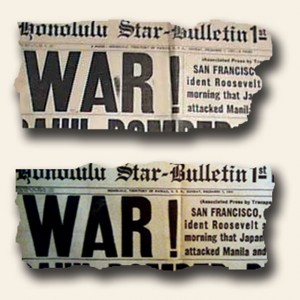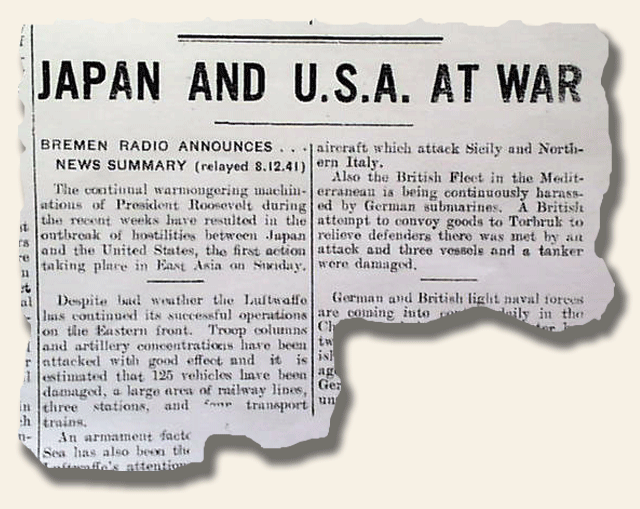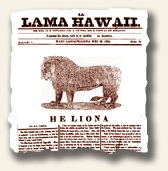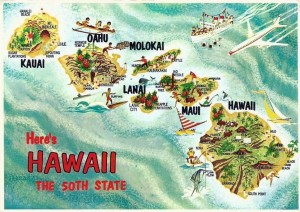Why Hawaii Became the 50th State…
November 12, 2015 by GuyHeilenman · 1 Comment
Authentic newspapers reporting Hawaii Statehood, especially those from Hawaii, have been sought by collectors for decades. The fascination for “all things Hawaii” appears to have no end in sight. It is with this in mind we bring to you the following guest-post from Francisco Meza:
Why Hawaii Became the 50th State
Hawaii, one of the tiniest states and the only one made up entirely of islands, formally became the 50th state in 1959 (August 21, 1959). But Hawaii’s story starts long before 1959. Polynesians, the earliest inhabitants of these islands, settled here over 1,000 years ago. British explorer Captain James Cook, in 1778, named them the Sandwich Islands. Fortunately, this name didn’t stick. Shortly thereafter, American traders made a beeline for Hawaii’s sandalwood. From July 7, 1898, Hawaiian Islands were an organized incorporated territory of the US.
Why did it Take So Long?
The genuinely interesting question about the Hawaiian Islands becoming a state is the reason it took so long. Over sixty years elapsed from the time Hawaii had become a US possession before it became the 50th state. There were several Hawaiian petitions for statehood in the early part of the 20th century. These petitions were either denied or ignored altogether. Some in the US had felt that the Hawaiian Islands had no natural connection with the remainder of the mainland US. Most obviously, Hawaii wasn’t a contiguous territory. It lay 2,000 miles from the US coast.
American Plantation Owners Resented Paying Import Taxes
The clout of the American plantation owners in Hawaii resulted in its annexation in 1898. The protection of the plantations owners’ financial interests played a huge part too. They were keen on gaining exemption from paying import taxes for the sugar that they shipped to the mainland US. The plantation owners also wanted to safeguard their large land holdings from possible confiscation or annexation under a renewed Hawaiian monarchy.
The US Administration and Citizens Didn’t Favor Annexation of Hawaii
The sentiment in the US about the annexation of the Hawaiian Islands was always strong. The people felt it’d be an imperialistic, unjust, and hence, a most un-American move. Hawaii wasn’t only about sugar. It was an important coaling station for naval vessels, as well as, a potential major harbor. In the 18th and 19th centuries, Great Britain, Russia, and Japan had pressured Hawaii for trade concessions.
The Reasons for the Delay
At the time of annexation (1898), the monarchy had been in existence for just about a century. Originally, the monarchy had leveraged the firepower of the European sailors to consolidate power. An element of brutality was involved too. A high percentage of Hawaii’s Caucasian residents had been there for so long that they considered themselves native. Additionally, numerous Chinese, Portuguese, and Japanese immigrants had come to Hawaii as agricultural laborers and settled down permanently.
Polynesian Hawaiians Wanted to Maintain the Status Quo Because They Considered the Sizable Japanese Populace in Hawaii a Threat to Polynesian Prosperity
The six-decade reluctance to alter Hawaii’s status from a US territory to state lay both within the Hawaiian Islands and the US mainland. In the mainland, it concerned the uncertainty and fear about permitting electoral authority to any one ethnic group. It wasn’t merely ethnically Polynesian versus Caucasian.
In the Hawaiian Islands, some ethnically Polynesian Hawaiians didn’t favor the change to a US state from the existing US territory. This is mainly because, although they were comfortable feeling almost “American” as long as Hawaii was a US territory, they were apprehensive that’d change in case Hawaii became a state. After WWII had ended, the occupation of Japan by the Allies fuelled their fears even more. The Polynesian Hawaiians’ fears originated from a belief that the Japanese populace on the Hawaiian Islands (almost as high as 30 percent) would, in the event of universal franchise that statehood authorized, organize and vote itself into leadership. And Polynesian Hawaiians considered that the Japanese ascent to Hawaii leadership would result in an overall Polynesian descent in Hawaii.
Factors that Favored Hawaii Becoming the 50th State
At the instant of the vote to statehood, almost 90 percent of Hawaii’s populace comprised US citizens. The importance of Hawaii in WWII had secured its identity as 100 percent American both in the minds of the mainlanders as well as the Hawaiians. Additionally, persistent and successful lobbying of Congressional representatives in the initial phase of the contemporary Civil Rights Movement swayed enough members of Congress into accepting the Hawaiian statehood. They were prepared to overlook the islands’ racial makeup.
Why Didn’t Guam or America Samoa Become a State Too?
Almost 18 years after the Pearl Harbor attack, Hawaii, considered a distant frontier of American settlement, was declared a US state in 1959. Since the 1820s, European Americans had settled down in Hawaii and established English as a language. Additionally, an American-style legal system had been introduced early on, and the US dollar was the main currency.
In the case of American Samoa, indigenous Samoans make up almost 90 percent of the population. Hence, it’s unlikely that American Samoa will ever become a US state. In the case of Guam, the indigenous Chamorros make up almost 37 percent of the population. The remainder includes Filipinos, Chinese, Whites, Japanese, Micronesians, Vietnamese, Koreans, and Indians. It’s highly unlikely that Guam will become a US state in the near future.
Summary
After WWII had ended, Hawaiians themselves desired US statehood. Even during the 14-year intervening period before Hawaii was formally conferred statehood, the “49th State” Record Label was immensely popular in the Hawaiian Islands. Eventually, Alaska became the 49th state at the beginning of 1959. Several months later, Hawaii became the 50th.
If you are ever in Hawaii and want to learn about Hawaiian culture, take a few Hawaii Tours that encompass Oahu and the other islands. You’ll learn see where the Hawaiian battles happened, see the beautiful nature, and stop by Pearl Harbor.
© Francisco Meza
The Last Surviving Veterans Who Served at Pearl Harbor…
October 22, 2015 by GuyHeilenman · Leave a Comment
Collecting World War II era newspapers covering significant events continues to be popular among collectors, even though the number of WWII veterans continues to decline. Authentic issues of the Honolulu Star-Bulletin reporting the Pearl Harbor tragedy certainly stand above them all. It is with this in mind we are pleased to post the following article compliments of Francisco Mesa.
The Last Surviving Veterans Who Served at Pearl Harbor
As the years roll by, the list of surviving US veterans of WWII who served at Pearl Harbor when the Japanese Navy attacked the US Navy’s Pacific Fleet inevitably becomes shorter. And with the Pearl Harbor survivors well past their late 80s and some passing even the ripe-old century mark, their numbers are dwindling rapidly all over the US. Last year, just about 2,000 survivors were thought to be around, still.
National Pearl Harbor Remembrance Day
On December 7, 2014, the US President Barrack Obama designated December 7 as the National Pearl Harbor Remembrance Day. Four veterans of the remaining 9 USS Arizona survivors gathered at the Pearl Harbor Visitor Center on December 7, 2014, for a meeting of USS Arizona survivors. The veterans were greeted by music and military salutes from the US Navy Band. Later, they viewed a live feed of an underwater dive beside USS Arizona’s sunken hull that still holds over 900 bodies. For the veterans, each return to Pearl Harbor brings back intense and, sometimes, painful memories.
USS Arizona Reunion Association’s Last Gathering at Hawaii
Although it was the last formal survivor gathering of the erstwhile USS Arizona Reunion Association at Hawaii, the veterans said they still intend to get together—if not in Hawaii, somewhere in the US. Louis Conter, 93, felt he still had some time, and he’d come back to the Pearl Harbor Visitor Center regardless of who else makes it.
Donald Stratton, USS Arizona Survivor
Donald Stratton, 92, of Colorado is another USS Arizona survivor. Don Stratton had been manning the Anti-Aircraft gun batteries. He remained at his battle station on the ship’s port side until the last possible moment. He endured 65 percent burns and a one-year hospitalization. Stratton was medically discharged from the US Navy but re-enlisted a year later. He said that the good Lord saved a precious few from the USS Arizona.
John Anderson, USS Arizona Survivor
John Anderson, 97, was ordered off the USS Arizona, but he wasn’t willing to leave behind his twin brother, Delbert. Although Anderson was forced into a boat and packed off to the safer Ford Island, he returned in an empty boat and rescued three shipmates. Sadly, he didn’t find his brother. Anderson recalled that he had just attended church services that day and had been heading to breakfast when someone warned that the Japanese planes were coming.
Anderson Recalls the Harrowing Experience
Anderson remembers lying in a bomb-blast crater on Ford Island after the surprise attack. He had picked up a rifle and two bandoliers of ammunition and started firing at Japanese aircraft. Anderson had hunkered there through that night with another sailor. In the morning, a passing Marine patrol informed him that survivors of the USS Arizona had to gather at the dock nearby to facilitate a head count. Anderson remembers everyone he saw having rags around their heads. He clearly recalls bandages covered their arms and their skin had been scorched, and their hair had been burned off.
Lauren Bruner, USS Arizona Survivor
Lauren Bruner, 94, had been alongside Don Stratton manning his battle station. There were four others as well. Bruner had escaped from the fiery, sinking battleship by shimmying across a rope that dangled 60 feet above Pearl Harbor’s waters. Bruner had been standing just 70 feet from the spot the torpedo bomb had exploded at the USS Arizona’s forward magazine. He suffered almost 75 percent burns. But that didn’t deter him. Bruner and his comrades were intent on fighting back. There was only one thing that hampered them … they just had to survive the next few moments. So, after catching the attention of one sailor aboard the warship moored alongside their own, a rope stretching almost 100 feet was thrown across.
The Sailors’ Great Escape from the Burning USS Arizona
All the 6 men made the painful—all of them had suffered serious burns—hand-over-hand escape. They had dangled 60 feet in the air as huge flames rising from the oily harbor had burned their skin even more. Bruner had been the second last to leave USS Arizona. Alvin Dvorak, the last one to escape over the rope, had been the one that caught the attention of the sailor on the USS Vestal. Unfortunately, Dvorak succumbed after spending 17 days in the hospital. He had suffered 84 percent burns. Lauren Bruner considers Alvin Dvorak to be the true hero of their great escape. Bruner spent the next seven months in the hospital and returned to the Pacific theater.
Conclusion
Although the survivors of Pearl Harbor are in their early or mid 90s, they can recall the Japanese sneak attack vividly. Many of the survivors fondly hope to live long enough to attend the 75th anniversary of the Pearl Harbor strike in Hawaii on December 7, 2016.
If you are ever visit Hawaii, there are several Pearl Harbor tours that range from just a couple hours to a full day. There are still droplets of oil coming out of the sunken battleship USS Arizona. Also, there are hundreds of people still entombed within the sunken battleship. It is said that the droplets of oil represent the crying of the fallen men and women. And when the droplets of oil stop, the crying will stop.
© Francisco Meza
Hawaiian Islands… ignorance is often the default position of the uninformed…
October 17, 2014 by GuyHeilenman · Leave a Comment
 While many have been rightfully moved by James Michener’s account of the 1800’s Hawaiian Island pandemic, and have been forced to wrestle with and ultimately accept the albeit unintentional but horrible spread of disease and death often associated with well-intended explorers and missionaries entering new lands, an article in the National Intelligencer (December 4, 1849) takes “ignorance” to a whole new level. The image to the right expresses at least one person’s “uninformed” reaction to the wide-spread death that had befallen many of the indigenous people of the Hawaiian Islands (Sandwich Islands). Captain Cook and those who followed (with the intention of bringing Good News) would never have guessed they were also bringing such overwhelming human destruction. Thankfully we now know better – so as to not make such cold-hearted statements as the one made in this mid-19th century newspaper.
While many have been rightfully moved by James Michener’s account of the 1800’s Hawaiian Island pandemic, and have been forced to wrestle with and ultimately accept the albeit unintentional but horrible spread of disease and death often associated with well-intended explorers and missionaries entering new lands, an article in the National Intelligencer (December 4, 1849) takes “ignorance” to a whole new level. The image to the right expresses at least one person’s “uninformed” reaction to the wide-spread death that had befallen many of the indigenous people of the Hawaiian Islands (Sandwich Islands). Captain Cook and those who followed (with the intention of bringing Good News) would never have guessed they were also bringing such overwhelming human destruction. Thankfully we now know better – so as to not make such cold-hearted statements as the one made in this mid-19th century newspaper.
How the West Was Won – Go East Young Man?
August 29, 2014 by GuyHeilenman · Leave a Comment
An article within a National Intelligencer from January 18, 1849 instantly expanded my perspective on the California Gold Rush of 1848-1851. Heretofore I had only viewed the rush traffic flowing in a single direction. Apparently, as revealed in the article shown below, this was limited thinking. In retrospect, I wonder how many would have wished they had stayed and purchased beach-front property? Note: The Sandwich Islands mentioned are what is now known as the Hawaiian Islands.
The reprint issues of the “Honolulu Star-Bulletin” Pearl Harbor issue…
May 14, 2012 by TimHughes · 30 Comments
 If there is a second in line for the most common phone call or email about a newspaper which turns out to be a reprint, it would be the December 7, 1941 of the “Honolulu Star-Bulletin – 1st Extra“.
If there is a second in line for the most common phone call or email about a newspaper which turns out to be a reprint, it would be the December 7, 1941 of the “Honolulu Star-Bulletin – 1st Extra“.
The genuine issue is arguably the best newspaper to have reporting the historic bombing of Pearl Harbor, being a dramatic headline, from the day it happened, and from where it happened. And consequently those conditions make it ripe for creating a reprint edition. From what I understand the reprints are still available at the souvenir shop at the Pearl Harbor memorial.
There are a couple of tell-tale indicators which are easily observed:
* The genuine issue has an ink smear between the “A” and “R” in the huge “WAR ! ” in the headline.
* The reprint edition does not have the ink smear, it having been “cleaned up” to make for a better appearance.
* The genuine “1st Extra” is 8 pages and does not have the “2nd Extra” nor the “3rd Extra” within, as they were separate, stand-alone edition printed later in the day. The reprint editions typically have one of both of the later editions on pages 3 and/or 5.
* At least one of the reprint edition has the front page of the “Honolulu Advertiser” newspaper on page 3. Obviously a competing newspaper’s front page would not be found within a genuine issue of the “Star-Bulletin”.
As if the above are not sufficient in determine a genuine from reprint edition, the photos of the reprints typically have a “muddy” appearance and are not as crisp & clear as would be found in the genuine issue.
Hawaii’s first “regular” newspaper…
May 30, 2011 by TimHughes · 2 Comments
 In a previous post we discussed the first newspaper in Hawaii was essentially a student newspaper, titled “Ka Lama Hawaii” (The Hawaiian Luminary), done by Protestant missionaries at their school at Lahainaluna on the island of Maui. But it was just a few months later when the second newspaper in Hawaii–and considered the first “regular” newspaper on the islands–was published. “Ke Kumu Hawaii” began publication on Nov. 12, 1834 (some references cite an October beginning which cannot be verified).
In a previous post we discussed the first newspaper in Hawaii was essentially a student newspaper, titled “Ka Lama Hawaii” (The Hawaiian Luminary), done by Protestant missionaries at their school at Lahainaluna on the island of Maui. But it was just a few months later when the second newspaper in Hawaii–and considered the first “regular” newspaper on the islands–was published. “Ke Kumu Hawaii” began publication on Nov. 12, 1834 (some references cite an October beginning which cannot be verified).
We were fortunate to bring into our inventory the volume one, number two issue of this title, dated Nov. 26, 1834. Very similar in size to “Ka Lama Hawaii” it contains 8 pages, 6 of which are in the Hawaiian language. Rather than a student, or school newspaper, this was a regular newspaper for the general public.
We provide photos of this very rare newspaper for our friends to enjoy.
Roosevelt to blame for the Pearl Harbor attack…
October 16, 2010 by TimHughes · Leave a Comment
We often list on our website issues from the island of Guernsey during World War II when it was occupied by the Nazis. As such all news is filtered through the German propaganda machine which offers interesting reading, as the reports are in English because the residents speak English.
Although many battles reports border on the absurd, particularly with historical hindsight, the front page report in the “Evening Press” dated December 8, 1941, one day after the Pearl Harbor attack, is one of the more outrageous (see the photo below).
A great rarity comes into our inventory…
October 7, 2010 by TimHughes · Leave a Comment
 One of the more rare items in the world of early newspaper collecting has come into our inventory: a collection of the very first newspaper in Hawaii, including the volume one, number one issue.
One of the more rare items in the world of early newspaper collecting has come into our inventory: a collection of the very first newspaper in Hawaii, including the volume one, number one issue.
Hawaii’s first newspaper was essentially a student newspaper, titled “Ka Lama Hawaii” (The Hawaiian Luminary), done by Protestant missionaries at their school at Lahainaluna on the island of Maui. The missionaries transported a printing press some 18,000 miles around Cape Horn to Hawaii, setting up what would become the very first newspaper building west of the Rocky Mountains. The newspaper was printed in the Hawaiian language on the manually operated flatbed press which could turn out 100 sheets per hour. Content included articles on government, Christian teachings, and in keeping with the educational element, illustrations of exotic animals like the lion, elephant and zebra. The very first issue, dated Feb. 14, 1834, was dominated by an essay on the habits & habitats of the lion.
This newspaper lasted for just these 25 issues printed in 1834, then did not print for several years only to resurrect itself to print just two final issues in January, 1841. Not only is it the first newspaper in Hawaii, but it also predates any newspaper in North America west of the Rocky Mountains.
We felt these rare issues were worth sharing with fellow collectors.


First newspapers in Hawaii…
February 22, 2010 by TimHughes · Leave a Comment
The American Board of Foreign Missions sent a printing press to Hawaii in 1820, but it wasn’t until fourteen years later that a periodical was printed in the islands.  Hawaii’s first newspaper was done by students of a missionary seminary on the island of Maui on Feb. 14, 1834, titled: “Ka Lama Hawaii” (Hawaiian Luminary). A similar paper titled “Ke Kumu Hawaii” appeared in Honolulu in October of the same year. Both were printed in the Hawaiian language.
Hawaii’s first newspaper was done by students of a missionary seminary on the island of Maui on Feb. 14, 1834, titled: “Ka Lama Hawaii” (Hawaiian Luminary). A similar paper titled “Ke Kumu Hawaii” appeared in Honolulu in October of the same year. Both were printed in the Hawaiian language.
In 1836, two years after Hawaiian language newspapers took hold, the first English language paper was born, the “Sandwich Island Gazette and Journal of Commerce“. This newspaper was only printed sporadically and lasted for just three years. It wasn’t until 1856 that the first regular English language paper was established, the weekly “Pacific Commercial Advertiser“. The “Advertiser” has published continuously since then, switching names to today’s Honolulu Advertiser in 1921.
The first newspaper printed in Hawaii…
March 5, 2009 by TimHughes · Leave a Comment
As was typical with the first newspaper publishing efforts in states and territories, the very first newspaper in Hawaii didn’t have great success. The SANDWICH ISLAND GAZETTE, published its first issue on July 30, 1836 and only lasted until 1839. Shortly after its demise came the SANDWICH ISLAND MIRROR & COMMERCIAL GAZETTE which lasted for less than a year. Although bearing a different name and issued monthly instead of weekly, it was essentially a continuation of the GAZETTE.
 Early printing in the Hawaiian Islands were by missionaries, and the SANDWICH ISLAND GAZETTE was no exception. Some of the content has religious overtones, however there is much secular reporting and advertisements as well.
Early printing in the Hawaiian Islands were by missionaries, and the SANDWICH ISLAND GAZETTE was no exception. Some of the content has religious overtones, however there is much secular reporting and advertisements as well.
We are pleased to share with out collectors our July 8, 1837 issue of the SANDWICH ISLAND GAZETTE, the volume 1, number 50 issue. Newspapers from Hawaii in the 1830’s are virtually unheard of in the collector market today.
Enjoy.






